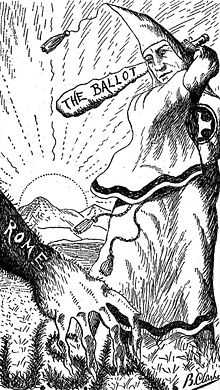William N. McNulty
Dean (Christianity) William N. McNulty (1829-1922), was an American pioneer Roman Catholic priest, who arrived in New York from his native Ballyshannon, Ireland in 1850, during the time of the Great Irish Potato Famine and when, there, then, existed little in the way of Roman Catholic facilities about near by Passaic County, New Jersey. He is responsible for much of the foundation of the structural and institutional infrastructure of today’s Roman Catholic Church in Paterson, New Jersey.[1] To the end of his 93 years, a simple parish priest and caring steward of his flock, he refused the Pope’s appointment of him as a Domestic prelate and, even, the then powerful Ku Klux Klan could not intimidate this beloved priest’s honored 1922 burial. Father “Mac” as he was affectionately known in Paterson was so revered by its Irish and German Roman Catholic communities that his mere admonishing appearance in midst of Passaic County’s 1880 Garret Rock May Day Riot or what national newspaper coverage of the time called “the most serious riot that has ever occurred in that section of the country” was sufficient to permit police to thereafter act to end the rioting. During his lifetime, the Pope, anyway, accorded this truly Reverend Father the extraordinary honor of naming him to the office of Papal chamberlain, which office is normally the reserve of European nobility. Father McNulty lies in front of Paterson’s St. John’s Church under an honoring bronze monument of his counseling a parish youth.
Enduring contribution to the Roman Catholic infrastructure of Paterson, New Jersey
During some of the course of his 65 years as an ordained Roman Catholic priest, the Reverend Father McNulty acted as the moving force behind the creation of most of the foundation of Paterson, New Jersey’s Roman Catholic infrastructure, including St. John (later in 1937 upon that Diocese's formation renamed Cathedral Church of the Diocese of Paterson), St. Joseph, St. Agnes, St. Mary, Our Lady of Victories, St. Michael and St. Ann’s Churches, Holy Sepulcher Cemetery, St. Joseph’s Hospital, St. Agnes Institute Girl’s School, St. Francis Home for Working Girls, the Home for the Indigent Poor and Aged, Mt. St. Joseph’s Home for Boys and convents for Dominican and orders of teaching sisters.[2]
1880 Garret Rock May Day Riot
The Reverend Father McNulty was so revered by the Irish and German Roman Catholic communities of Patterson that his mere appearance in midst of Passaic County’s 1880 Garret Rock May Day rioting at request of then Patterson Mayor Graham and Sheriff Van Voorhies was admonishment sufficient to diffuse the mob to the point where the constabulary could act to end the rioting.[3][4]
a simple, caring parish priest to the end of his 93 years
When Father McNulty was presented a purse of $ 24,000 for his personal use on the occasion of his 1908 golden jubilee of priesthood, he instead used the funds to build the Mount St. Joseph Home for Boys. Throughout his service as a parish priest, he often shared his own dole to instead feed his parish’s hungry families or pay college tuitions of poor parish youth. He was also known for preserving the food and housing funds of many parish families by actually wresting pay envelopes from his reprobate parishioners before they could dissipate, these, their family’s earnings in Patterson’s bars. It is said that Patterson’s barkeeps came to fear the Reverend Father more than they did the police or thugs.[5]
Ku Klux Klan attempt to intimidate the Reverend Father’s honored burial

The Reverend Father William McNulty was also so beloved by the population of Paterson, New Jersey that when he finally died at 93 years of age in 1922, then, Patterson Mayor Frank J. Van Noort declared the day of the Reverend Father McNulty’s funeral a holiday with the closure of both parochial and secular schools and the flying of flags at half mast, over the protest of the Ku Klux Klan,[6] which was then at the height of its political power in the U.S., claiming 15% of the nation’s voters as Klan members.[7]
See also
History of the Ku Klux Klan in New Jersey
References
- ↑ Encyclopedia of New Jersey, Maxine Lurie and Marc Mappen, eds., Rutgers: Rutgers University Press (2004) ISBN 0813533252, 9780813533254 p 495
- ↑ Alfred Cappio Dean William McNulty Passaic County Historical Society Publication, Volume 1971, No. 4
- ↑ J. Bilby, H. Ziegler and J. Madden Hidden History of New Jersey The History Press (2011) ISBN 1609494636, 9781609494636 “Trouble On Garret Mountain” p 70-76
- ↑ The National Police Gazette: New York, May 15, 1880, p. 3, also noting the rioting as “the most serious riot that has ever occurred in that section of the country”.
- ↑ Alfred Cappio Dean William McNulty Passaic County Historical Society Publication, Volume 1971, No. 4
- ↑ New York Times “Ku Klux Protest Honor to Late Dean”, Business & Opportunity Section, p 36, June 22, 1922
- ↑ Lay, Shawn. "Ku Klux Klan in the Twentieth Century". The New Georgia Encyclopedia. Coker College.